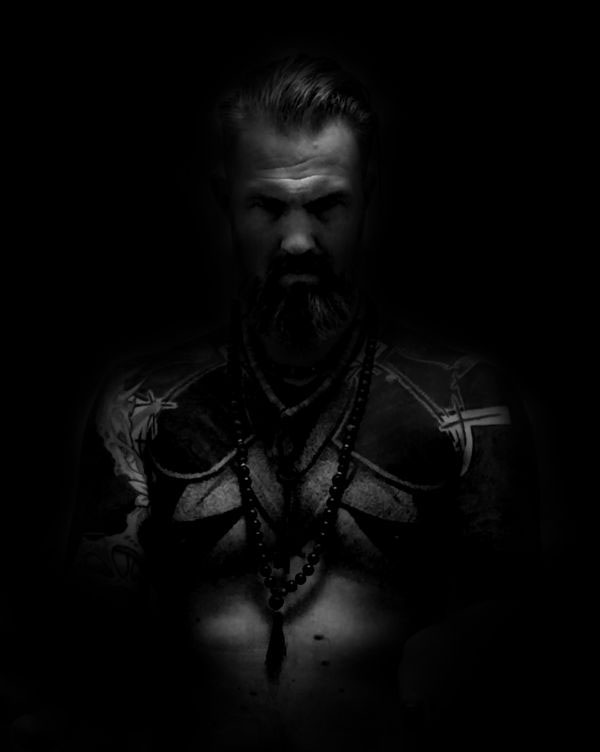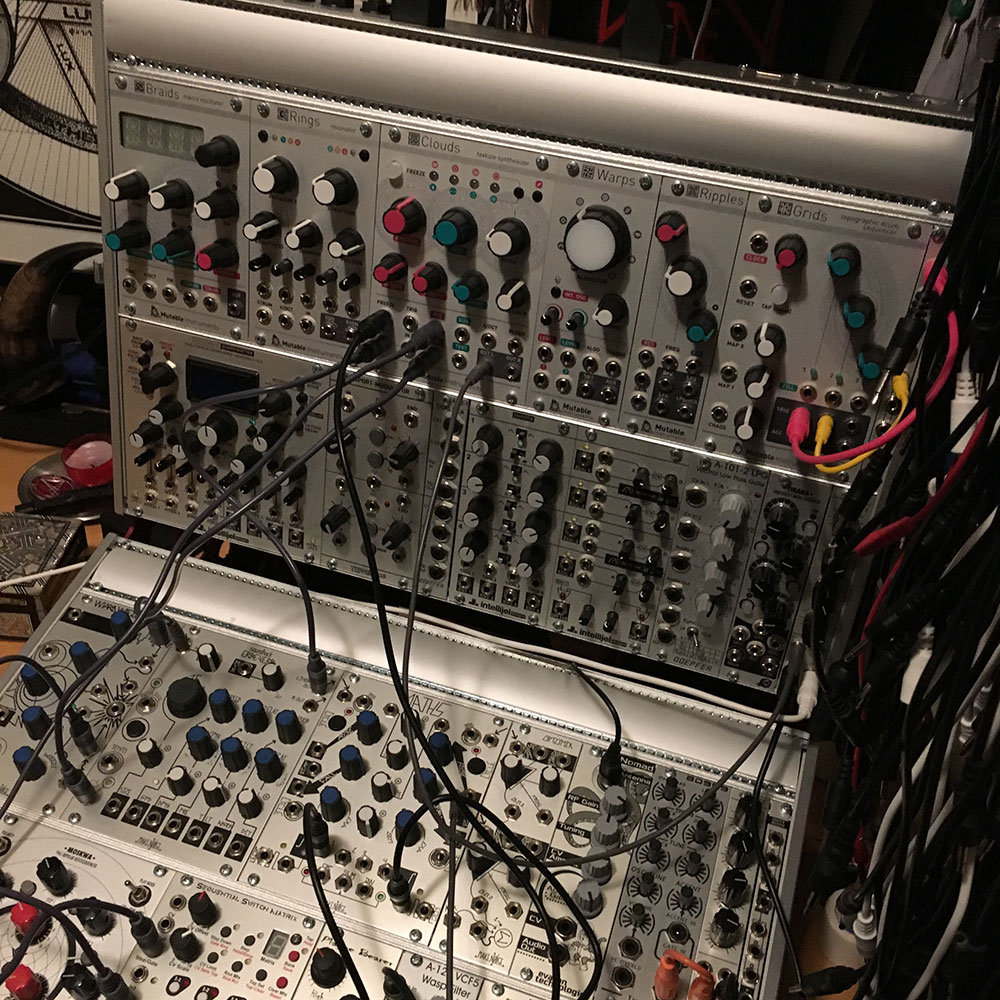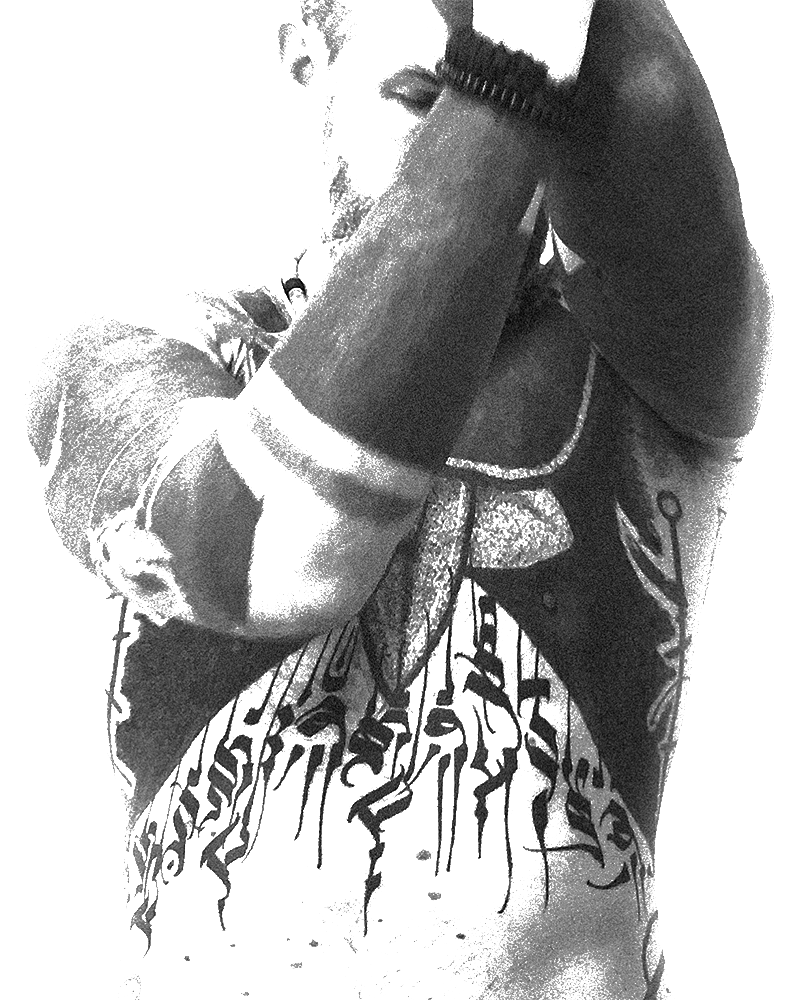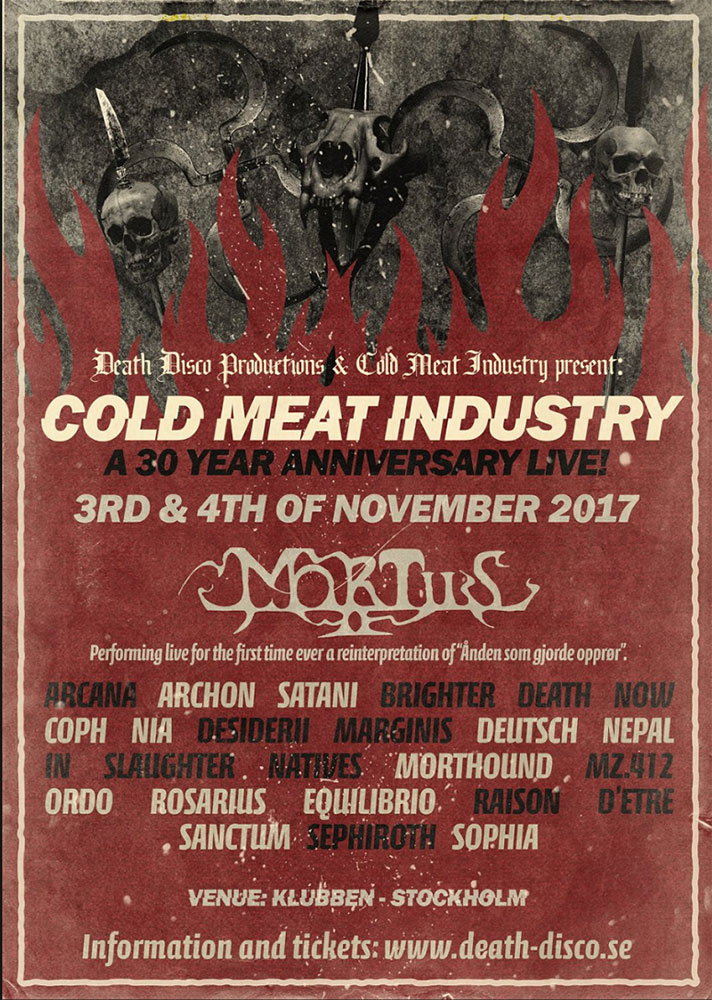Nordvargr (Mz.412, Folkstorm)
2017-08-09
by Niklas Göransson
Henrik Nordvargr Björkk, mastermind behind Swedish black industrial pioneers Mz.412 and martial industrial project Folkstorm, has been infusing malicious electricity in music for three decades – he now grants exclusive insight into what fuels it.
– My brain is constantly analysing all sounds coming from the surroundings. Melodies, scales and harmony never really interested me – I find far more music in the screech of a broken bicycle brake or a chair falling on an oak floor. There’s a lot of depth to process out of such noises, I just wish I had a decent quality audio-recorder on me at all times.
Psychoacoustics, the scientific study of how sound can be used to alter the human body and mind, has seen plenty of discussion on Bardo Methodology. I shudder at the notion of what someone with Henrik’s musical experience and understanding could achieve by combining this technology with his usual sonic output.
– On the “Sleep Therapy” box-set that was released around ten years ago, I experimented with theta and delta waves in order to affect the listener’s sleep. It was very interesting, quite a few sent me extensive reports about how the music had affected them. Some ran into serious problems with dreams, whereas others claimed to have never slept better.
Henrik says that given the respondents’ wide-ranging testimonies, it was difficult to draw any tangible conclusions in regards to efficacy.
– I suspect it was placebo effects to a large extent; many probably wanted bad and evil dreams because that’s what people expect from me. None of it was recorded with such intentions though, but who knows… perhaps some of the darkness from my other work rubbed off? Other than that, I’ve not dabbled much with psychoacoustics. The subtle vibrations infused in my music tend to be of a more ’magical’ kind.

This brings to mind two quotes I made note of while reading a 2012 interview with one decidedly disenchanted Nordvargr.
I have come to the conclusion that nothing really exists beyond death. It is all like dreamless sleep. Like before you were born. Nothing.
I have lost faith in everything. I worship the great nothing. There is nothing more than here and now. Make the best of it. Be the alpha and omega. Make babies if you believe your offspring will be strong enough to deal with this cruel world. Live life to the fullest.
– Being reminded of those comments now makes me smile at my past ignorance. I’ve been exploring a lot of different systems and schools of thought for as far back as I can remember. It all started in my teens when I discovered Thee Temple ov Psychick Youth, which led me to Crowley, Jung, Spare, LaVey, and so on. After many years of experimentation, frustrated by the lack of results as well as no one to interact and discuss these matters with … I kind of lost it and turned to ignorance and disillusion.
Henrik adds that one notion from this bitter rant of five years ago which still resonates with him is living one’s life to the utmost.
– ’Yolo’, as my teenage daughter says. As for the rest, I now know there’s more to existence than what can be detected with our primitive senses. It’s just a matter of connecting with the right vibrations, powers, and archetypes to realise how we’re so much more than just chemical processes bound in flesh.
One clue which led me to suspect some manner of arcane relapse was Henrik’s most recent dark ambient release under the Nordvargr moniker; “The Secret Barbarous Names”. Those chants do not sound as if they’re coming from someone without a vested interest in the numinous.
– That was a vastly different approach for me, using ninety-five percent vocals and simply channelling the material rather than composing it in a classic sense. Kenneth Grant’s Typhonian Trilogies was highly beneficial to my understanding of how to establish a connection with the powers that guided me.
Kenneth Grant, once the personal secretary of Aleister Crowley, was a British ceremonial magician and renegade Thelemite. Long before Grant’s passing in 2011, his ideas and writings garnered significant attention from many areas of the Western esoteric community.
– A fun trivia about “The Secret Barbarous Names” is how the entire recording process was triggered by me getting a cold. I noticed how different my throat sounded, so I decided to put myself in a trance state and record the outcome. My bacterially altered voice was only accessible that day as I quickly recovered from the sickness, but I managed to get a few good rants in. This became a foundation to build the remaining album on.
So the actual mantras and invocations were all improvised?
– Yes, nothing was written or planned beforehand. I just set up my studio and lit some incense, then went into meditation and let it flow freely. Perhaps I divulged profound secrets, I might have been speaking in foreign tongues, or maybe I was just spouting nonsense – I’ll leave that up to the listener.
At times, Henrik’s vocals sound reminiscent of the Tibetan style of throat chanting.
– Seeing as I’ve used my voice in all kinds of ways since my musical journey began in the eighties, I’ve always held a keen interest in unorthodox vocal application. Seeking inspiration, I’ve listened to a lot of Tibetan-style throat chanting, overtone singing and even joik. It was never my intention to master any specific technique or tradition, I just experiment and follow my intuition; if it feels and sounds good, I’ll use it. I wanted to find my own way rather than copying someone else’s style – PHURPA comes to mind.
Henrik refers to these mantras as ’words of power’ – invocations that, if vibrated at their requisite frequency and amplitude in the right place at the right time, can influence our physical realm.
– This is a theory I’ve adopted from many sources; ritual practices such as the aforementioned Tibetan chanting, the Enochian system, and everything in-between. Vibrational currents capable of unleashing incredible power flows within us. The right resonance or combinations of words can unlock things you didn’t even know existed, it can help you accomplish virtually anything. There are no limits, only the boundaries you set for yourself, and it’s not even necessary to use external means such as drugs to attain higher states or realise one’s true will.
Henrik has previously mentioned that he’s always carried out his composing without ulterior sensory enhancements – which makes sense from listening to much of his extensive back catalogue. It offers significantly more of a harsh, cold, and mechanised anger than certain surreal and otherworldly sentiments associated with music conceived under botanical guidance. Notable exceptions to this are some of his latest work.
– I’m still composing everything sober and with a clear head, if that’s the implication here. This dreamy feeling on my recent material is the result of ritual experiments, channelling and meditation – not drugs.
Still, I’d be deathly curious how a FOLKSTORM album written under such conditions would turn out.
– Haha! … I somehow doubt it would sound much like FOLKSTORM, more like Kalle Jularbo (renowned Swedish accordionist).

In recent years, modular synthesisers have seen a vibrant resurgence among audio producers and music magazines. Henrik is no exception. Usually featuring ungodly amounts of knobs, cables and input sockets, they look more like the work station of an old-school telephone operator than a musical instrument. Modular synths get their name from being comprised of various free-standing but connected modules, employed to manipulate amplitude, effects, frequency, and so forth.
– To me, it’s all about the interface. Using hardware, modular synths in particular, forces my mind to work in ways it couldn’t have done otherwise. You engage the sounds on a far deeper level – from generating basic waveforms to moulding their shape, filtering out frequencies, clocking stuff… the list goes on. Learn all the mechanics behind it and you’ll end up with a better – and different – understanding of the complete picture.
While this discovery has essentially revolutionised his approach to music, Henrik is entirely unmoved by the time-honoured debate of digital versus analogue.
– I’ll use anything that sounds good, regardless of how it was created. Sure; things might change from the conversion into ones and zeros, but it doesn’t bother me as long as it’s done correctly.
To sample Henrik’s work with modular synths, a good place to start is the largely improvised 2011 album “Tyglad best”.
– It was my second all-improv recording – “Otyglad best” from the same year being my first, a noisy and crazy affair conveyed through a Crowphonics system. If memory serves me correctly, for “Tyglad best” I started out with quite an advanced patch containing many elements and possible variations to work with, so the improvisational parts would still be full of variation. One could easily do a simple drone improv after only a few minutes of preparation, but adding more options and interesting sounds requires some work beforehand.
Can you describe the sensation you felt while performing it?
– When I get ’in the zone’ with my modular, I’m totally robotic – I become utterly absorbed by the process. I merge into one with my machine and think in abstract electricity, at least that’s what it feels like to me.
The way he describes the process reminds me of ‘flow states’, as they’re known in modern nomenclature.
– Yes, sounds very familiar… I think it’s mostly my subconscious manifesting in the waking mind – which is why it sometimes feels quite alien or strange, even though it’s just a natural flow of thoughts. However, sometimes I utilise certain meditation techniques before recording or writing music, and that’s where the really weird magic happens.
But there’s no divine connection to the Muse?
– I’ve been getting so much out of myself all these years, so in the long run there’s been no one to ’muse’ me. I must admit though, the ANIMA NOSTRA collaborations with Margaux Renaudin mused the shit out of me. Together, we tapped into unknown depths hidden within us both – it turned out extremely creative and fruitful.
Margaux Renaudin is primarily a visual artist. While I have yet to see a physical copy the new ANIMA NOSTRA album, “Atraments”, the aesthetic aspect of their 2016 debut appears to have had substantial efforts invested in it.
– Our aim was to blend the album’s visual and audible parts as much as possible, to weave a shroud of mystery around the whole thing. We experienced many strange phenomena during the recordings and decided to create a sigil for each track – to capture the magic of every individual composition with an image. I think she did an awesome job designing it all.
“Atraments” is quite the shift in mood from the first, self-titled ANIMA NOSTRA album. While retaining an atmospheric spiritual connection, it’s far darker and almost hostile.
– I’m not sure why it progressed like that. The initial plan was to move towards a pulsating soundscape – more hypnotic and carnal – but things developed into an increasingly musical affair. I wouldn’t call it hostile, but it’s way more confrontational and lively than the first album. We’d written a lot of texts, words deserving of being sung rather than just printed on a cover. One could sense a touch of MZ.412 in the sound, and that might not be totally wrong as we haven’t recorded any new material for a long time – perhaps I had some old un-exorcised demons clawing inside me…
Speaking of which, any new MZ.412 material on the horizon?
– Not really, but a seven-cassette box-set is currently being prepared. I’ve also finished new albums of both FOLKSTORM and Nordvargr. On top of that I’m currently working on a soundtrack for a Polish crime film premiering this autumn. Another individual who’s quite recently been a great inspiration and creative collaborator is Thomas Ekelund of TREPANERINGSRITUALEN, so much that we even started up a band together; DET KÄTTERSKA FÖRBUND – debut vinyl out via Cold Spring this autumn.

I came across a recent picture showing Henrik having acquired a plethora of fairly striking tattoos, which made me curious about the designs.
– I’m a huge fan of tattoos, but not in the classic sense. I prefer massive blackwork and ornamental pieces, and have no interest in the artform’s ’normal’ styles. I want them to become one with the body, to accentuate lines and curves or drastically alter one’s entire look – like blacking out entire parts. Almost all of mine fall into that category. I also do most tattoo work myself, so yes – the designs are my own.
As in tattooing yourself?
– Indeed. I’m not, and will never be, a tattoo artist but I know the basics and have tattooed a handful of people besides myself. I exclusively perform massive blackwork though, no traditional rubbish – total darkness only.
Besides the ink-work, Henrik has created almost every logo and seal used in his own releases – leading me to suspect an interest in symbolism.
– Symbols are hugely important to the human mind – this is indisputable, just look at advertising. I can certainly relate to Jung´s theories but I’ve also done plenty of research on my own, looking into connections between sigils, logos and symbols. They’re basically the same thing but their uses differ; where symbols primarily evoke feelings and memories embedded in your consciousness, sigils bridge over to the subconscious and engage your will.
Henrik suggests that combining these might be possible in order to target the beholder’s deepest, most primal and clandestine thoughts.
– That’s where things get interesting to me. When I construct a logo or symbol, I want it to be able to move the viewer on his most primal and instinctive level. It’s obviously a bonus if it looks appealing, but the goal is to reach beyond mundane aesthetics.
What’s next for Henrik Björkk?
– I have a lot cooking right now, as per usual – several re-issues coming, such as the Nordvargr/Drakh “Northern Dark Supremacy” CD and boxset. Then there’s a collaboration with Romain Perrot which will end up on cassette, a ten-inch vinyl with DET KÄTTERSKA FÖRBUND, a split CD featuring ANIMA NOSTRA and SHIBALBA, and a Nordvargr live album. Not many shows booked unfortunately but I have some plans for Russia in October, and of course there’s the already mythic CMI event.
This fabled spectacle is the Cold Meat Industries 30th anniversary festival in November 2017, of which’s line-up is nothing short of spectacular for any old fan of the label.




